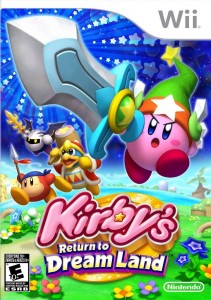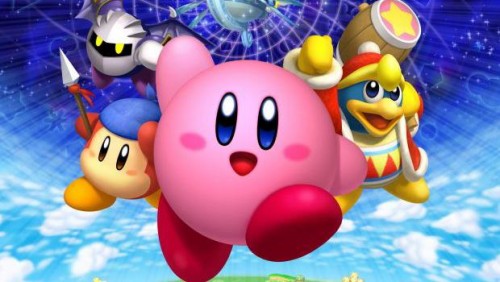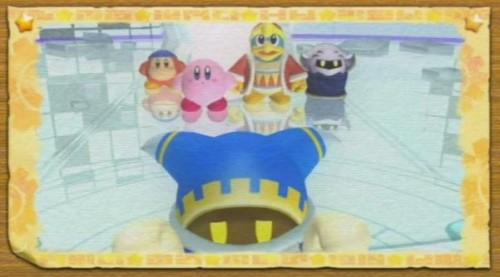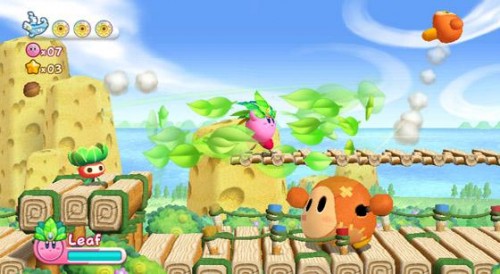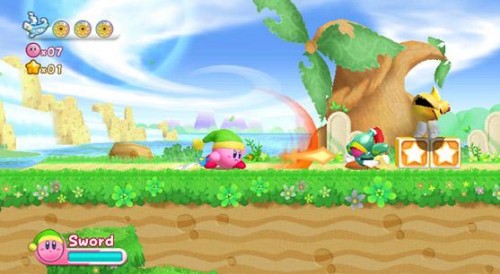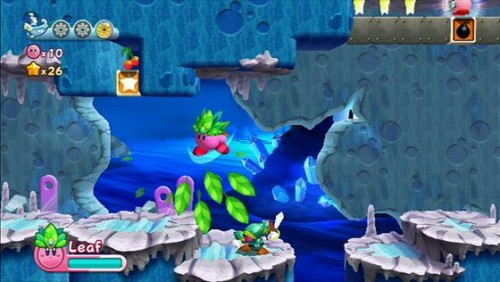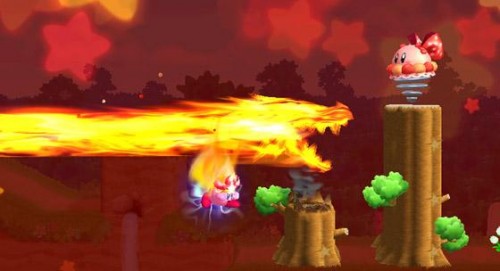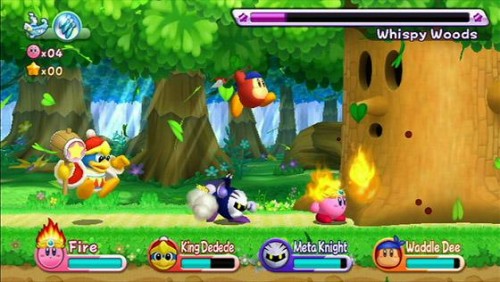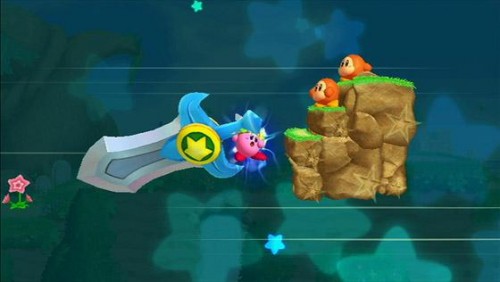Game Name: Kirby’s Return to Dream Land
Platform(s): Nintendo Wii
Publisher(s): Nintendo,
Developer(s): HAL Laboratory
Genre(s): Platformer
Release Date: October 24, 2011 (US) November 25, 2011 (EU)
Price: $49.99
BUY NOW!
If you were a gamer growing up in the 90’s, you more than likely had a favorite mascot from the generation that you still stand behind as of today. Capcom fanatics are still ever-passionate about Mega-Man, Mario and Link could still sell anything with their famous logos and names attached, and good ol’ Sonic is still speeding along due to his passionate following. I was always the odd man out growing up though, as my favorite mascot was the ever cheerful Kirby. While many icons of the industry have showed a fierce amount of evolution in terms of visuals and more challenging gameplay, the Kirby series has went a different route and focused more on re-invention by sticking the pink fluff into titles that fully utilized the technology of whatever platform they were released for while keeping the same charms that made the mascot a household name. There is no doubt that those games were fantastic additions to the series, but I have hungered for years for a completely traditional Kirby game with no gimmickry or strings attached (Don’t worry Yarn Kirby, I still love you).
After over ten years of being put on the back burner, Kirby is finally ready to fully return to his ability copying roots that made him such a star years ago with Kirby’s Return to Dream Land. This brand new adventure adds in a few new features that have never been seen in the platforming romps of the past, but aims in a bigger way to re-capture the magic that Kirby Super Star and Dream Land 3 brought us over 15 years ago. It’s quite an ambitious task for the little pink fluff, but thankfully the final product delivered more than this Kirby fan could have ever asked for. Without further ado, here is my review for Kirby’s Return to Dream Land.
Story
Kirby’s Return to Dream Land starts out with Kirby, Waddle Dee, and King Dedede playfully chasing eachother over a delicious cake while Meta-Knight partakes in some reading. Soon after, a large alien ship interrupts these casual events when it crash lands on Planet Popstar, leading the quartet of characters to drop everything and go investigate. The “Kirby Krew” find a small alien aboard the fallen vessel, who explains that his ship is now wrecked and 5 crucial pieces are scattered about the colorful world. Without much hesitation, the group decide to assist and set out to recover these ship pieces so the alien can safely return home.
As you could probably tell, the narrative here stays true to the light-hearted nature of the series. This is in no way a bad thing though, as there is so much personality in the entire plot that one doesn’t have to emerge themselves in any deep details or jaw-dropping cinematics to easily tag along on this delightful adventure. Find ship pieces and make an alien happy. That is your mission, and Kirby and his friends seem so thrilled to be helping that it’s hard not to want to achieve this objective for them.
As players trek through Planet Popstar, they are treated to many classic enemies from the past such as Bronto Burt, Broom-Hatter, and many past mid-bosses that have not appeared in a Kirby title for quite some time. It isn’t all about the old though, as new enemies have made their debut in Return to Dream Land and as one would expect, they fit in perfectly in the upbeat and familiar locations. Yes, this game is loaded with fan service and new treats for those who have followed the series, but as always the game retains it’s inviting quality for newcomers, allowing everyone to benefit from all of Dream Land’s charms and personality.
Gameplay
As I mentioned, Kirby’s Return to Dream Land is about the purest form of a Kirby title we have seen since the days of the Super Nintendo and a platformer at it’s core from beginning to end. Being on the Wii, a system that is known for adding in some kind of motion-controlled mechanic, my biggest worry was that this game in particular would have some form of gimmick stapled into it, just to fit with the platform. Thankfully, that is not the case though as for the most part, everything stays simple in terms of control and players will be able to waddle through Dream Land with just the Wiimote turned sideways. As always, Kirby can jump and inhale air to float for an infinite amount of time, run by double tapping the forward button, and perform a quick slide to glide out of danger. These commands are performed without error and are so easy to execute that just about everyone shouldn’t have much of a problem in mastering the basics in just a few minutes. Let’s be honest though. You probably don’t care much to hear all about that though. This is the game where abilities return, so let’s start talking about Kirby’s most famous trait. The suckage.
At the touch of a button, Kirby can instantly suck in an enemy into his large mouth. When the same button is hit again, our pink fluff fires their remains out in star form, which can be used as a damaging projectile if needed. An upgrade to this old feature also lets Kirby now consume even larger enemies and even pieces of the stage by waggling the Wiimote while inhaling. As always, whenever the player hits down to swallow a particular enemy, their powers are absorbed and Kirby dons the look and abilities of his former meal. Many of the trademark techniques such as Rock, Needle and Sword Return, but with extra moves offered for each depending on the combination entered. For instance, if you inhale Needle foe, you can stab all enemies around you by hitting the action button, or hit an alternate combo to take off in a pointy spin-dash or form one large spike to nail an enemy up above. This large amount of variation makes each ability much more rewarding to use and keeps the gameplay constantly changing, making for no feelings of repetition during the entire experience.
To go along with the over 20 abilities Kirby can possess come the many stages within the game. Much like Kirby’s Adventure, Return to Dream Land is broken down into a handful of worlds. Each of these locations vary in theme and are made up of 5 standard stages and one boss room at the end. HAL could have easily gotten away with just running with a setting change and still kept the game fresh due to the how the gameplay changes up for each world, but I was very impressed to see just how different each level felt from the next. The basic objective of each level is to collect all of the energy spheres you can while passing through star doors until you reach the end. Sometimes you will have to find a key or defeat a boss to make it to the next star door, but the game rarely breaks away from the classic concept of “reaching the end” that nearly every traditional title in the franchise has offered.
What does change up quite often though is the level design. Nearly every stage feels distinct due to the mass amount of gameplay changes that players will encounter. At times, Kirby will go through one level in classic form, just swallowing up and defeating enemies along the way. Other moments however offer up some swimming, controlling Kirby as he is sucked through a wind tunnel, and having to steer as you parasol safely to the ground, just to name a few. All of this variation is perfectly paced and fits into whatever stage you may be on, which is kind like entering that last missing puzzle piece. The Kirby series as a whole is quite known for offering up brilliant level design, but I honestly felt that Return to Dream Land excelled in this area even more so as each new stage brought new ideas to the table, making progression even more rewarding as a result.
There have also been new additions this time around. If you happen to see a glowing enemy, Kirby can inhale their powers and gain a Super Ability. These work almost the same as standard techniques, but with a much more powerful result. If you get the Sword, Kirby will lash out a blade 10 times his size and use it to destroy any enemy in sight as well as the environment. Others include the likes of turning our pink hero into a giant snowball to roll through all foes in your path, taking on the power of a beam where you can control giant orbs, and launching a blazing stream of fire that is sure to burn everything to a crisp once executed. Yes, these attacks are as awesome as they sound and since they are not a common occurrence, it can feel pretty special to stumble upon a shiny foe and unlock his (or her?) epic secrets. These Super Abilities usually lead to yet another new feature, Star Portals. Nearly every other stage has one of these mysterious areas where the player is thrown into a world without color and must run from an aura before it crushes Kirby flat. It’s quite a hectic change of pace, but a welcome change considering the rewards that await at the end of each one of these events.
The most promoted new feature however lies in the game’s multiplayer. I am sure many remember New Super Mario Bros. famous multiplayer mode, and Return to Dream Land is very similar as other players can take the roles of Waddle Dee, Meta-Knight, and Dedede (or just four differently colored Kirby) and play through the game in it’s entirety with four player co-op. There is a lot of teamwork that can be done in this mode and each new protagonist feature their own distinct styles, giving a great reason to call up some friends to join in on the action. We all know how co-op modes usually go though. Someone leaves and the game just doesn’t feel the same playing solo as many challenges cannot be reached as they are exclusive to multiplayer participation. Luckily, this is not the case for Kirby as the co-op is just an addition and takes nothing away from the single player experience. All of the stages are well designed to handle four players at once too, so no one should feel any crowding due to all of the players being on the screen at the same time.
After it was all said and done, I completed the entire game in around 7 hours. Since it’s a Kirby game in general, most will not find a lot of challenge if they just breeze through. Yes, the simplicity is still there, but that doesn’t deter Kirby from putting on a fantastic show from beginning to end. Seasoned gamers who are looking for a test of wits though will find one in trying to 100% the game though, as trying to track down each one of the 120 energy spheres can be quite a test in itself. Bonus areas also open up as the game is completed, offering certain challenges for specific abilities and a mix of fun little mini-games to kill some time with. If all of that wasn’t enough, a much harder version of the entire story mode can be unlocked, which gives bosses new fighting tactics and offers a more hectic style of play.
Visuals/Audio
If you have ever stared at fireworks in awe or ever seen a fantastic light display that made your draw drop, that feeling is exactly how I would compare the visuals in Kirby’s Return to Dream Land. The entire world is brightly colored and reeks of charm and cuteness the entire way through. It’s that kind of warmness that can make even the angriest gamer feel calm after just a few minutes time and yet another endearing quality that the franchise has been built upon. Each model for every character in the game is polished as well, giving off some of the best visuals the Wii has seen to date. Minor animations also go a long way to bring out Kirby’s care-free personality as well, with Kirby surfing or ice skating through Planet PopStar when donning the appropriate hat. No, you won’t get a 1080p masterpiece, but players should definitely expect their eyes to be taken on a marvelous journey that is full of wonder and quirky Kirby charm.
The soundtrack is also a pleasant affair, with past tunes returning in classic and redone form that are sure to make Kirby nuts dance for joy. Each track matches whatever level you may be on as well, so if you are gazing upon a starry backdrop amongst the clouds, you will hear a tranquil song bring the environment to life. There is quite a variety in all and even though I still prefer the music Epic Yarn had to offer, HAL certainly made sure sound was just as an important feature for Kirby’s return to the Wii. Nothing has really been done to Kirby’s voice, but those little squeals of joy and concern still capture his puffy personality well and keep everything light-hearted, no matter how serious the situation is at hand.
Overall
I don’t think there is much doubt that the Nintendo Wii has had a very slow year in 2011. With that said, I feel like this game completely redeems the slow period and gives any owner of the platform new reason to get their console back as a prominent piece of their gaming setup. Kirby doesn’t try to push any limits or change up everything you would expect from a platformer in this adventure, but instead offers what feels like a relaxing vacation from the AAA blockbusters that we have seen so prominently released. 15 years ago, video games weren’t meant to make you have deep thoughts or make you chuck your controller in sheer frustration, they were simply around to entertain. That is what this title is all about. 100% care-free fun with a mascot of the same mindset. Kirby’s Return to Dream Land is this generation’s balance at the other end of the scale, and quite possibly the best Nintendo Wii game to date.



